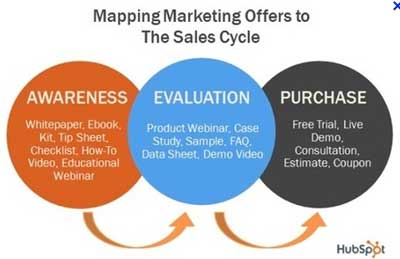Create Content for the Three Initial Marketing Stages
Hey, here's a riddle for you:
What is the single most important part of your business, which will always be beyond your control?
The answer? Your customers, of course.
It might seem obvious to say, but the main goal of marketing is to change your customers' behavior. You have to have them to stay in business, and you have to keep trying out new ways of guiding them to your door. Much like a fisherman trying out different lures, we'll never have a complete picture of what a customer's thought process looks like, but we've got a pretty good idea.
There's a popular “funnel” model of the sales process, from the point of view of the consumer, which is summed up with three basic steps:

Problem Awareness: The customer becomes aware of a need going unfulfilled and begins researching it.
Research and Evaluation: The customer starts looking for information on their problem and potential solutions.
Comparison of Alternative Prior to Purchase: The customer compares potential solutions and decides on one, preferably your product.
However, in this model, we're not consumers. We're selling something. In fact, good marketing means pitching your marketing content differently for people at each of those three stages. So, let's turn that funnel inside out and talk instead about how you should be marketing yourself to fit these stages.
Oh, and one important distinction: you may not be leading an individual customer step-by-step through these phases. Write a range of content so there's something to appeal to any customer who wanders along at any stage in the sales process.
Phase 1: Selling The Solution
One way or the other, we're in business to provide solutions to problems. However, any given problem a customer might have is likely to have multiple solutions. It might not even be a problem the customer is aware of until we bring it up. Either way, the first step towards getting their sale is convincing them they have a problem, and that a solution like yours is a good option.
To get the word out, try:
Blogs about problems on your website and how your class of products can help.
Short videos. (Think about how infomercials sell everyday problems, then be less blatant.)
eBooks, Checklists (“Are You (problem) Ready?”), Whitepapers, and other similar materials.
Social media updates mentioning the problem and asking about solutions.
Phase 2: Selling Your Product
Once the customer believes they have a problem and it's something you, or a company like yours, can do something about, it's time to start convincing them that your products are the best specific solution. This is the point to start bringing out the bigger guns:
Detailed product descriptions and spec sheets.
Free webinars or filmed discussions.
Slideshows with feature comparisons.
Product reviews.
Free samples or demos.
Phase 3: Selling Yourself
So, we're now looking at the remaining potential customers who both have a problem and believe products you carry are the solution. However, there's still one more thing that has to be sold: yourself. Chances are, even if you have a unique product or service, there are still parity problems out there. To seal the deal, you have to convince them that YOU are worth doing business with.
Try:
Free consultations.
Detailed case studies \ portfolios.
Customer testimonials.
Coupons or other promotions.
Leveraging social connections on Facebook and LinkedIn to improve your image.
Marketing in Three Easy Steps
That's it. If you can sell the problem, your solution, and yourself, you've made yourself a customer. If you ensure all your online content is always aiming towards at least one of these phases, you'll be catching more fish in no time.
Call DeepSky Marketing to find out how you can create profitable marketing strategies for your company. DeepSky Marketing is a company that provides businesses with profitable marketing systems and verifiable return on investment (ROI). To schedule a brief no-cost consultation call 707 823-3888.
MORE RECENT BLOGS
How to structure your all-important offer! (in 90 seconds)
Your offer is the entry point into the sales process. A good offer sets up success; a lackluster one doesn’t. Here are best practices: A good offer co...
AI is Changing Business. Are You Ready?
In a world where AI is surging, our innate human intuition is becoming more crucial than ever before. An AI class just for you Artificial Intelligence...
Is It Time For a Website Redesign?
You'd have to be pretty satisfied with the performance of your website not to occasionally look at it and wonder if it's time to redesign it. After al...
Graphic Design: Setting Tone and Mood On Your Site
As the Internet continues to develop and evolve and show us new ways to market, we're continually finding new ways of "embedding" messages into our co...
From Vision to Results (read in 30 seconds)
Getting real-world results from the vision in your head and heart is charted in the list below. Vision informs goals. Goals lead to planning. Planning...



